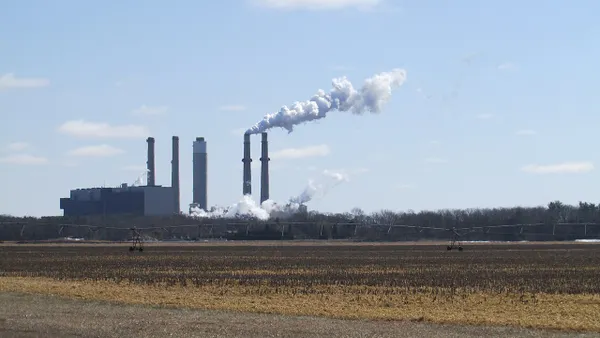Utility-renewables partnerships are emerging as fundamental to the U.S. power system, according to grid operators, utility representatives, and power producers at WindPower 2014, the annual industry event.
Utilities need to incorporate the distributed generation that is “at the intersection of energy technologies, regulations, and markets,” said Navigant Consulting Energy Managing Director Karin Corfee in a pre-conference workshop. Utility professionals say DG is one of their most pressing challenges because it has the “most disruptive potential,” she said, citing Utility Dive’s State of the Electric Industry 2014. But 65% acknowledge utilities must develop a new business model and 57% see DG as an opportunity.
Power and automation technology provider ABB showed ways to prepare the grid for more renewables at a pre-conference workshop. Presenters described new grid connection technologies to integrate microgrids and energy storage, manage reactive power, and meet the RTO and ISO grid codes that support transmission system reliability.
In the conference’s keynote session, NV Energy Renewable Energy VP Stacey Kusters described the utility’s plans to meet Nevada’s 25% renewables by 2025 mandate by shuttering and divesting 800 megawatts of coal generation in favor of nearly 500 megawatts of natural gas, 200 megawatts of utility-scale solar, three 100 megawatt RFPs for solar, geothermal, and wind, and a new high voltage line connecting the state’s northern and southern service areas.Utilities look at big changes from “the reliability perspective,” Kusters said. But NV Energy is developing “diverse resources that provide capacity and flexibility and will optimize renewable integration.”
A few years ago, grid operators said little about renewables except how they might bring down the system, a wind industry veteran observed at a session where representatives for the Southwest Power Pool (SPP), the Midcontinent Independent System Operator (MISO), PacifiCorp, the Electric Reliability Council of Texas (ERCOT), and Bonneville Power Authority (BPA) talked renewable integration.
They talked about how operators are regularly bringing on 10% renewables and occasionally bringing on up to 30% renewables without increasing rates or compromising reliability.
“Reliability is our main function, making sure the lights stay on,” said MISO Manager Marc Keyser. But with “interchange optimization” and new market practices, MISO has incorporated over 13 gigawatts of wind energy installed capacity and one day in March integrated 10.6 gigawatts.
“The variability of wind is very much dwarfed by the variability of load on our system,” Keyser said.
ERCOT got over 30% of its load from wind earlier this year “without an increase in the price of electricity,” said Infigen Energy-US VP David Smith. “And there is still room to build.”
Early renewables development produced little opposition in Texas, Smith said, but as the interconnection queue fills, traditional generators are beginning to raise questions. The grid operator is now facing questions about reactive power, ancillary services, resource adequacy, the queue process, reserve margin requirements, and forecasting.
A “new vision” of wind’s future was previewed by Department of Energy Wind and Water Program Manager Jose Zayas. “Wind is a part of this nation’s DNA,” he said in announcing that a “robust DOE analysis” concluded wind can move from 4.5% of U.S. power today to 10% in 2020, 20% in 2030, and 35% in 2050.
That level of growth will require the industry to add 10 gigawatts a year through 2030 and 18 gigawatts a year subsequently. In 2050, that wind growth will save 346 billion gallons of water, reduce the cost burden of fossil fuel emissions by $520 billion, and save U.S. electricity ratepayers an estimated 3% on their bills, Zayas said.
Can the wind industry build at 10 gigawatts a year? The question was posed, separately, to RES Americas President/CEO Susan Reilly and GE Renewable Energy CEO Anne McEntee. Both answered the same way. “We did it," they said. "In 2012, we built 13 gigawatts.”
Both also noted the same caveat: All the industry needs is policy certainty. Both were referring to the vital but on-again, off-again production tax credit (PTC). Wind’s triumphant 2012 was possible because the PTC had been in place for three years. Last year’s disappointing 6 gigawatts was because Congress delayed renewing the PTC for 2013 until January of this year. And Congress is once again leaving the PTC extension, and wind’s near term future, in doubt.
“PJM recently did a study and the integration looks like it’s there but that’s a lot of transmission. Is it doable?” Vestas President Chris Brown asked the RTO’s Renewable Services Manager Ken Schuyler.
“The study looked at different amounts of renewable energy penetrations up to 30%. It showed that would require additional transmission and frequency regulation resources,” Schuyler answered. For 20% renewables, the needed new transmission would cost about $4 billion. For 30% renewables it would be about $10 billion.
“That sounds like a lot but the PJM board last year authorized $4.6 billion for transmission construction and, since our expansion planning process began in 2000, the board has authorized $28.9 billion," he said. "So the amount needed to support renewables over the next fifteen years is not out of line with what we have already been doing.”






















